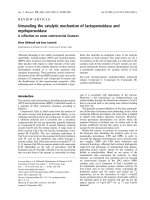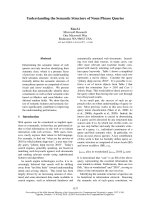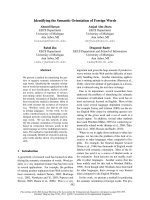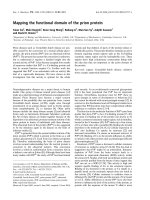Báo cáo khoa học: "Partitioning the work-sparing effects of partial ventilatory support in airflow obstruction" ppsx
Bạn đang xem bản rút gọn của tài liệu. Xem và tải ngay bản đầy đủ của tài liệu tại đây (31.11 KB, 2 trang )
101
CPAP = continuous positive airway pressure; EPAP = expiratory positive airway pressure; IPAP = inspiratory positive airway pressure; PEEP = pos-
itive end-expiratory pressure.
Available online />In this issue of Critical Care, Miro and colleagues [1] report
the results of an experiment designed to determine the
relative effects on work of breathing of the inspiratory and
expiratory components of applied airway pressure. After a
methacholine aerosol was used to induce bronchoconstriction
in spontaneously breathing, anesthetized dogs, equal levels
of inspiratory positive airway pressure (IPAP), expiratory
positive airway pressure (EPAP), and continuous positive
airway pressure (CPAP) were applied, and the pressures that
developed across the lungs and diaphragm were measured.
The authors concluded that any reduction in inspiratory effort
attributable to positive pressure during acute bronchospasm
is caused primarily by the IPAP component of the airway
pressure profile. Although I heartily agree that this
interpretation seems correct for the model and conditions
they examined, I suspect that the implications of this work
extend only to a small subset of patients with acute airflow
obstruction.
Fifteen years have passed since I was asked to write an
editorial [2], which was in response to a research paper by
Tuxen [3] that failed to show benefit from using positive end-
expiratory pressure (PEEP) in acute asthma. My point then –
as it is now – is that sweeping conclusions regarding the
utility or nonutility of elevating expiratory pressure are not
warranted. The effects of manipulating airway pressure in the
setting of airflow obstruction depend heavily on the nature
and severity of disease, as well as on the presence of airflow
limitation during tidal breathing.
Surely it comes as no surprise that a phasic boost of airway
pressure during inspiration would assist the inspiratory
muscles to accomplish their task of drawing fresh gas into
the lung. Because the lung is a passive structure, this
expectation follows directly from its simplified equation of
motion – P = FRi + Vt/C
L
+ PEEP
i
– and from the fact that
the work performed on the lung during inspiration is the
integral of pressure and flow over the inspiratory period. In
this equation, P is the transpulmonary pressure (the
difference between the pressures at the airway opening and
pleural space), F is flow rate, Ri is inspiratory resistance, Vt is
tidal volume, C
L
is lung compliance, and PEEP
i
is intrinsic
PEEP or auto-PEEP. With unchanging impedance properties
of Ri and C
L
, the job is set – at least for the same flow profile
and tidal volume.
Despite the mathematical certainty implied by this
relationship, in a sense I do agree with the authors’ statement
that ‘… neither the relative contribution of either EPAP or
IPAP, nor the mechanisms by which they exert their effect on
the work of breathing [emphasis added] are currently
understood’ [1]. The changes in breathing depth, breathing
Commentary
Partitioning the work-sparing effects of partial ventilatory
support in airflow obstruction
John J Marini
University of Minnesota
Correspondence: John J Marini,
Published online: 19 February 2004 Critical Care 2004, 8:101-102 (DOI 10.1186/cc2831)
This article is online at />© 2004 BioMed Central Ltd (Print ISSN 1364-8535; Online ISSN 1466-609X)
Abstract
Sweeping conclusions regarding the utility or nonutility of elevating expiratory pressure are not
warranted. The effects of manipulating airway pressure in the setting of airflow obstruction depend
heavily on the nature and severity of disease, as well as on the presence of airflow limitation during tidal
breathing.
Keywords airflow obstruction, CPAP, partial ventilatory support
102
Critical Care April 2004 Vol 8 No 2 Marini
rhythm, and muscle activation pattern evoked by these
modalities are not so easily predictable and have not been
well elucidated in patients or in normal human subjects, let
alone in spontaneously breathing animals.
Nonetheless, we do have some solid research observations
to guide us in this area. Many normal persons activate the
expiratory muscles to oppose end-expiratory pressure in
relation to the magnitude of the pressure applied and the
minute ventilation [4]. This attempt to reduce the lung’s end-
expiratory set-point is a wise strategy if the objective is to
avoid mechanically disadvantaging the inspiratory muscles by
hyperinflation and to allow the expiratory muscles to leverage
the applied airway pressure to aid their inspiratory
counterparts. A similar ‘work-sharing’ strategy is employed
routinely during exercise so as to avoid dynamic
hyperinflation under conditions of strenuous effort and high
minute ventilation [5].
A previous comparison of methods to raise end-expiratory
pressure conducted a quarter century ago by Katz and
colleagues [6] concluded that EPAP (e.g. inspiring at
ambient airway pressure but expiring through a hose placed
under water) was associated with greater inspiratory effort
(‘work of breathing’) than was CPAP, but less rise in cardiac
output-impeding pleural pressure. It is important to stress,
however, that those observations were not in patients with
airflow obstruction. In modern practice, there seems to be
little place for EPAP – CPAP fulfills the beneficial functions of
elevating expiratory pressure with less inspiratory workload,
less tendency to afterload the left ventricle, and only modest
effects on venous return. (Parenthetically, I cannot remember
encountering a spontaneously breathing patient whose
venous return was seriously affected by modest levels of
CPAP, but perhaps my memory fails me.)
With passive inflation, the work performed in moving the
integrated respiratory system (lungs and chest wall) can both
be measured and partitioned; during spontaneous or partially
assisted breathing, however, only the mechanical work of
inflating the lung can be assessed because the pressures
developed by the muscles in moving the chest wall cannot be
determined. At this point it is appropriate to note that
although ‘work’ is an emotive expression that suggests ‘effort’
or ‘exertion’, these two words are not synonymous. Isometric
effort generates pressure and raises oxygen consumption
without measurable work, and therefore the pressure–time
product correlates better with oxygen consumption.
Moreover, for the same externally measured workload, the
efficiency of the muscles in generating pleural pressure
varies with the configuration of the chest wall and the extent
to which the muscles are preloaded.
In the specific setting of airflow obstruction, raising end-
expiratory pressure has a variable effect, depending on the
degree to which it counterbalances auto-PEEP, evens the
distribution of ventilation, or leads to further hyperinflation. In
the study conducted by Miro and colleagues [1], the extent
of bronchoconstriction was very modest and no auto-PEEP
was generated. It follows that because no flow limitation
occurred during tidal breathing, EPAP would be unlikely to
help. Moreover, these anesthetized animals did not activate
their expiratory muscles sufficiently to raise intra-abdominal
pressure, limiting any potential ‘work-sharing’ benefit. In other
experimental or clinical circumstances, however, quite the
opposite conclusion might be justified. Reasoning from basic
principles, I would predict that a patient with dynamic
hyperinflation and flow limitation might obtain significant
benefit from the expiratory component of elevated airway
pressure. A similar comment applies to the patient making
forceful expiratory efforts. (Raised expiratory pressure might
also help even the distribution of ventilation among units with
varying levels of auto-PEEP.) Conversely, in a patient lacking
either expiratory flow limitation or activated expiratory
musculature, any increase in end-expiratory lung volume
could prove counterproductive, disadvantaging the
inspiratory muscles and perhaps reducing the compliance of
the respiratory system.
In the end, we cannot conclude on the basis of this
experimental work that raising expiratory airway pressure
does not make a major contribution to the work benefit
accruing to positive airway pressure in the setting of airflow
obstruction. However, although the implications of the study
are limited, I commend the authors for conducting an
interesting study of integrative physiology that directly
addresses a ‘real world’ medical question. Although not
trendy or fashionable in these days of exciting molecular
biology and influential clinical trials, such mechanism probing,
systems level physiologic investigations inform clinical
practice and deserve to be encouraged.
Competing interests
None declared.
References
1. Miro AM, Pinsky MR, Rogers PL: Effects of the components of
positive airway pressure on work of breathing during bron-
chospasm. Crit Care 2004, 8:R72-R81.
2. Marini JJ: Should PEEP be used in airflow obstruction? [editor-
ial]. Am Rev Respir Dis 1989, 140:1-3.
3. Tuxen DV: Detrimental effects of positive end-expiratory pres-
sure during controlled mechanical ventilation of patients with
severe airflow obstruction. Am Rev Respir Dis 1989, 140:5-9.
4. Chandra A, Coggeshall JW, Ravenscraft SA, Marini JJ: Hyperp-
nea limits the volume recruited by positive end-expiratory
pressure. Am J Resp Crit Care Med 1994, 150:911-917.
5. Grimby G, Bunn J, Mead J: Relative contribution of rib cage and
abdomen to ventilation during exercise. J Appl Physiol 1968,
24:159-166.
6. Schlobohm RM, Falltrick RT, Quan SF, Katz JA: Lung volumes,
mechanics, and oxygenation during spontaneous positive-
pressure ventilation: the advantage of CPAP over EPAP. Anes-
thesiology 1981, 55:416-422.









